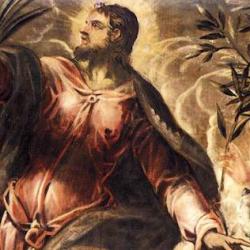Early Christians expended huge amounts of energy and intellectual subtlety in working out the implications of the gospel for their understanding of God and of Jesus. “Trinity” and “Christology” were the theological monuments of the patristic era. John MacIntyre (Shape of Soteriology) points out that we find nothing comparable on the question of the “relation of Christ’s death to our redemption.” Neither creeds nor theologians produced “a full theory of atonement” but were content to “employ a selection of the biblical expressions to describe the relation between Christ’s death and our salvation from sin.” When the creeds did mention the death of Jesus, they didn’t link it to the forgiveness of sins (6).
MacIntyre thinks this “so very, very odd as to merit much more consideration than it is traditionally given in histories of soteriology.” How are we to explain this absence of formal attention to soteriology?
MacIntyre suggests that “the first, and very important reason, for the absence of a full-blown soteriological definition comparable to the Trinitarian and Christological creeds, from the early Canons of the Church, must surely be the centrality not only of a soteriological theme, but of the direct connection between the death of Christ and the forgiveness of sins, to all the eucharistic liturgies of the Church.” He acknowledges that eucharistic liturgies different in many particulars, but finds “at the very heart of such liturgy, even if surrounded by other doxological and dogmatic statements embodied in prayers, an interpretation of the meaning of the eucharist which derives from the mind of Christ himself, as contained in the so-called ‘institution narrative’” (8). He cites Gregory Dix’s comment that the significant of Jesus death “was grasped by that church primarily through the eucharist, which arose directly out of what he had said and done at the last supper. There, and there alone, He had explicitly attached that particular meaning to His own death and office” (quoted p. 9).
Thus, “the understanding of the death of Christ, especially in relation to the forgiveness of human sin, lay at the heart of the eucharist, and the worship which it formed, and the part which it played there defined its role in the life of the church” (10). Instead of theorizing about Christ’s death, they were incorporated into Christ’s death by receiving His body and blood. It seems significant, then, that formalized theories began to arise in the high middle ages, when changes in the eucharistic liturgy distanced the people from the Eucharistic elements and so raised fresh questions about how the death of Christ, now distance and outside of us, could be related to us.
This is not a polemic against theologizing about atonement. It is a plea that theologizing be done from within the eucharist, where we do not contemplate the cross but share in Jesus and His gifts.










